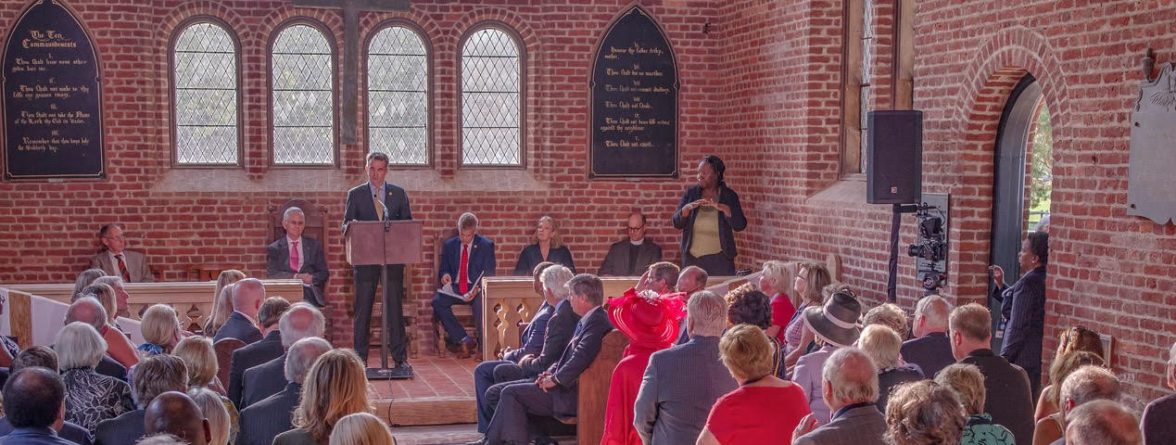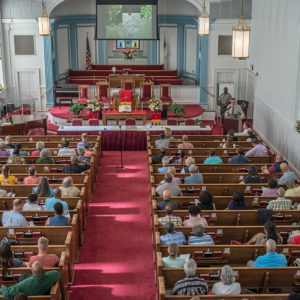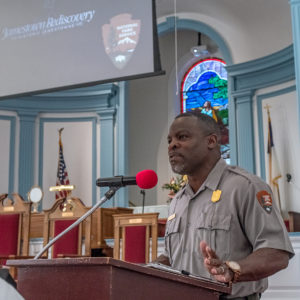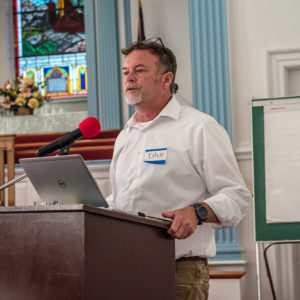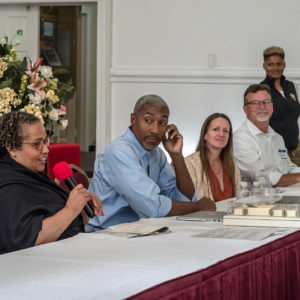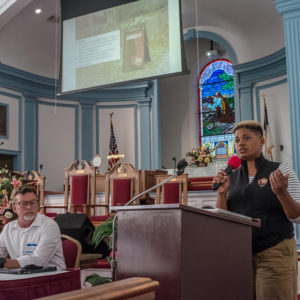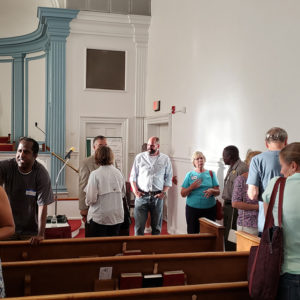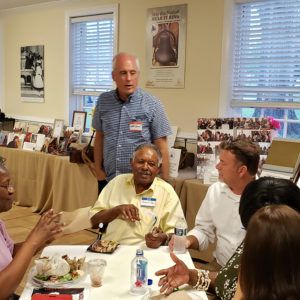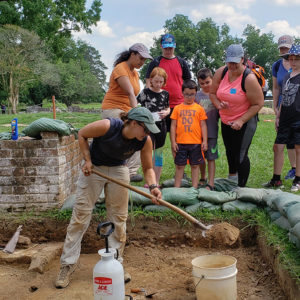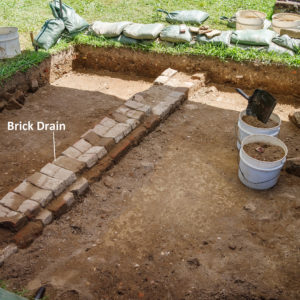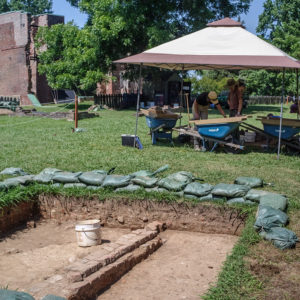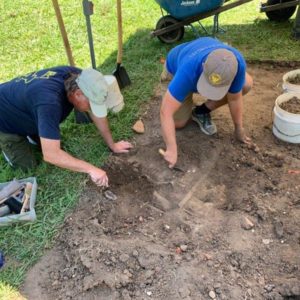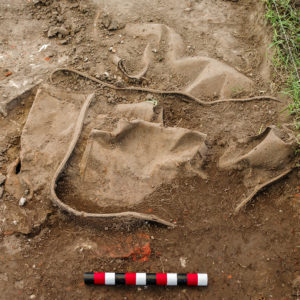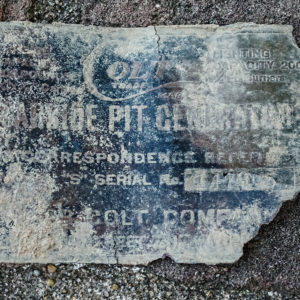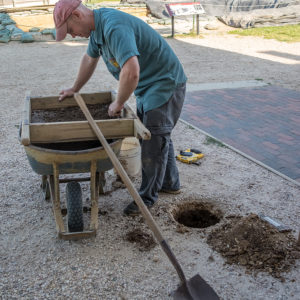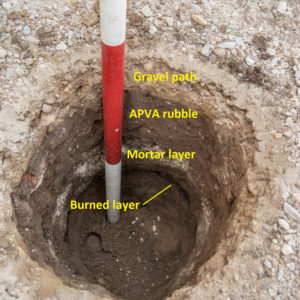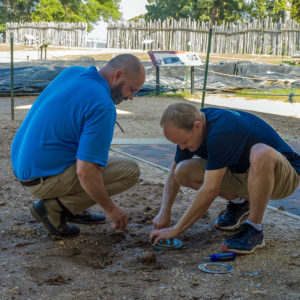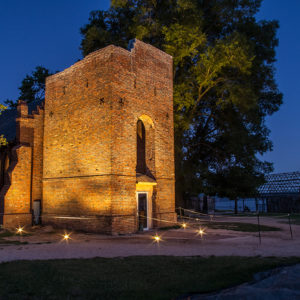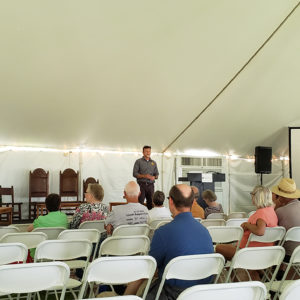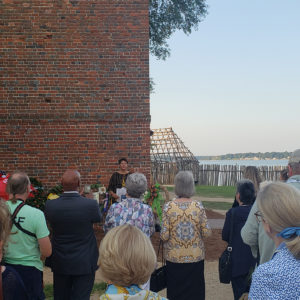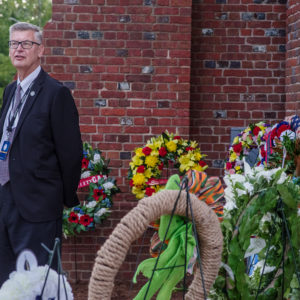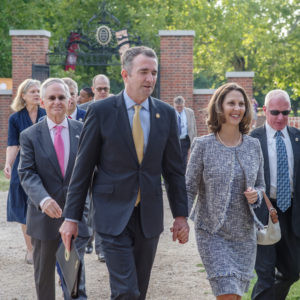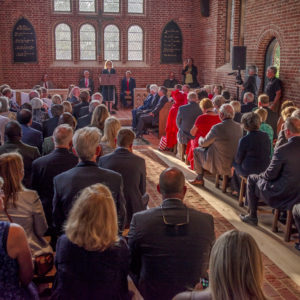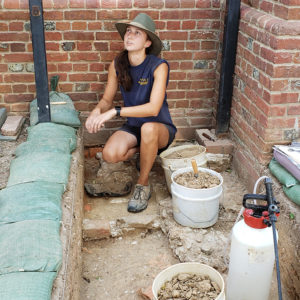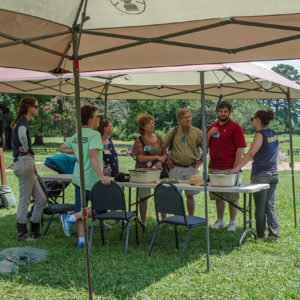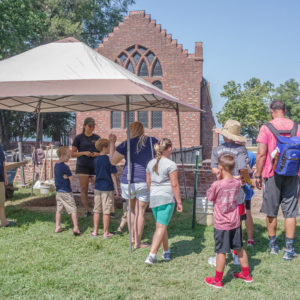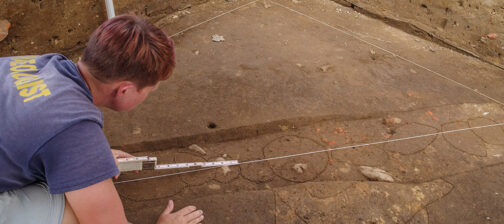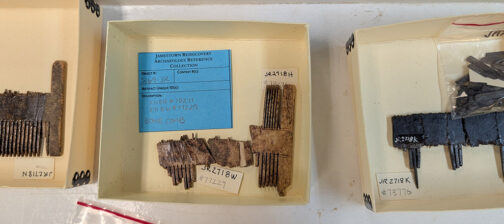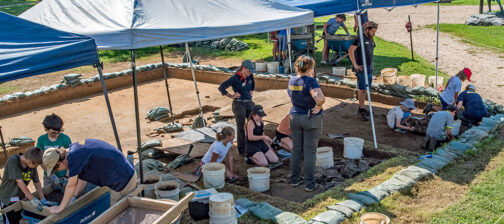Jamestown Rediscovery kicked off July by joining the Colonial National Park and Historic First Baptist Church of Williamsburg in hosting the third Community Outreach Meeting. Over 150 community members joined us at the Historic First Baptist Church to participate in a public conversation about research at the “Angela Site” and African-American history and culture at Historic Jamestowne. Colonial National Historical Park Superintendent Kym Hall, Deputy Superintendent Steven Williams, Jamestown Rediscovery Director of Archaeology David Givens, and Nathaniel Brown of the Historic First Baptist Church welcomed a diverse group of attendees in the beautiful church sanctuary. This was the first community meeting held off Jamestown Island.
This meeting specifically focused on human remains of possible African ancestry discovered at Jamestown during previous excavation projects. Community input was requested concerning respectful remembrance, appropriate study, and reburial with dignity. Presentations by David Givens, Dr. Audrey Horning of the College of William and Mary, Mary Elliott of the National Museum of African American History and Culture, and Dr. Joe Jones of the College of William and Mary provided valuable information and topics of discussion. The presenters discussed what research opportunities are possible that prioritize further learning and public engagement. Members of the community provided valuable feedback about how research goals can be best pursued and how to commemorate the pivotal events of 1619 this year and in the future. A dynamic and respectful dialogue ensued in the public forum moderated by Regional Cultural Anthropologist, Eola Dance, and continued during the reception following. Also in attendance was Mr. Purcell Bailey, whom Rediscovery interviewed earlier this year regarding his time with the Civilian Conservation Corps in Williamsburg during the late 1930s.
Rediscovery archaeologists working at the Angela Site this month finished the test unit begun in June and uncovered a brick drain. The drain was of box construction with bricks oriented east-west resting on their side and lining the outside of the drain, and bricks lying face up stretching north-south across the top between the outer lines. Many of the top bricks capping the drain were cracked or broken from years of bearing the weight of traffic on the ground above. The drain, likely relating to the Ambler period of occupation (mid-18th century), appears to head westward toward Ditch 1, which ran north-south and drained into the marsh.
The team also opened a new unit west of the drain to explore an area where ground penetrating radar (GPR) data indicated a deep anomaly thought to be a well or pit feature. The John Cotter map of Jamestown archaeology (1950s) shows that the Civilian Conservation Corps (CCC) excavators in the 1930s had tentatively drawn a dotted brick feature through the units there, suggesting that they did not understand how to interpret the brickwork they found. There was also some question as to whether or not the CCC had even left portions of the site unexcavated.
However, as Rediscovery removed the sod, instead of revealing a pit or well, they exposed the top of a large metal object, because sometimes, metal can interfere with GPR signal and reflect like a much deeper feature. Excavations revealed a carbide pit generator, which produced gas when gravel-sized pieces of carbide were dropped into water. Archaeologists speculate that it was used to provide the fuel for lamp light inside the nearby Ambler House in the late 1800s.
Around the church, archaeologists backfilled the test unit next to the Jamestown Church Tower and landscaped the area. They also completed three shovel test pits around the Tower so that ground lights couple be installed to illuminate the structure after dark. One of the tests revealed historic rubble likely resulting from the early 20th-century landscaping that followed the APVA excavations of the churches. Beneath was an interesting layer of mortar, which may relate to late 1890s restoration of the church tower. Finally, the test showed a layer of burned soil, which possibly dates to 17th -century activities in this part of James Fort.
The last week of July was filled with programing pertaining to the 400th Anniversary of the first meeting of the General Assembly and included several onsite reenactment performances of the assembly. Programs included lectures and tours about the first General Assembly, archaeological discoveries in the church, and the Angela Site led by Jamestown Rediscovery archaeologists, historians, and educators. Visitors engaged with archaeologists excavating outside the church, in the churchyard, and at the Angela Site. Education staff presented activities in the Education Shed and at a kid’s dig box at the Fort site.
The morning of July 30th, Rediscovery and Colonial National Park held a wreath laying ceremony at the old Church Tower with 24 groups participating. Directly following that service, Virginia Governor Ralph Northam and various dignitaries and delegates representing each of the original boroughs or plantations held a ceremony inside the 1907 Memorial Church to commemorate the first General Assembly. Here, the team uncovered archaeological evidence that pinpointed the exact location where that assembly was held and constructed a new exhibit interpreting this 1617-1618 church for visitors.
The short time-lapse video shows the Church Tower as it looks at night after the installation of the lights around it.
related images
- Nate Brown welcomes community members to the outreach meeting at First Baptist Church of Williamsburg
- Deputy Superintendent of Colonial National Park Steve Williams welcomes community members
- Rediscovery Director of Archaeology Dave Givens lectures about recent discoveries at the Angela Site
- Mary Elliot of the African American Museum of History and Culture speaks during the panel discussion with Dr. Joe Jones, Dr. Audrey Horning, Dave Givens, and moderator Eola Dance
- NPS Regional Cultural Anthropologist Eola Dance leads discussion
- Conversations following the community meeting at the First Baptist Church
- Dave Givens chats with Mr. Purcell Bailey and his wife Nellie after the community meeting
- Chardé Reid talks to visitors to the Angela Site while Angie Tomasura removes backfill from the 1930s excavations
- East unit of the Angela site
- Archaeologists moved west after finding the drain in order to explore an area that was possibly not excavated by the CCC in the 1930s
- Chuck Durfor and Bruce McRoberts expose the carbide pit generator
- Top of the carbide pit generator soon after it was uncovered
- Label for the carbide pit generator found near it
- Senior Staff Archaeologist Sean Romo screens dirt from a shovel test dug to install lights around the Church Tower
- Shovel test around the Church Tower
- Director of Collections and Conservation Michael Lavin helps install a light for the Tower
- The Church Tower at night after the light installation
- Director of Archaeology Dave Givens lectures on the Church excavations
- Community members gather for a wreath-laying ceremony at the Church Tower the morning of July 30, 2019
- Jamestown Rediscovery Foundation President Jim Horn makes closing remarks at the wreath-laying ceremony
- Virginia Governor Ralph Northam and his wife Pam walk to the Memorial Church
- Preservation Virginia CEO Elizabeth Kostelny speaks about the role women played in the first Church excavations
- Anna Shackelford talks to visitors outside the Memorial Church
- Staff and volunteers talk with visitors to the Angela Site
- Nicole Roenicke talks to visitors at the churchyard site


